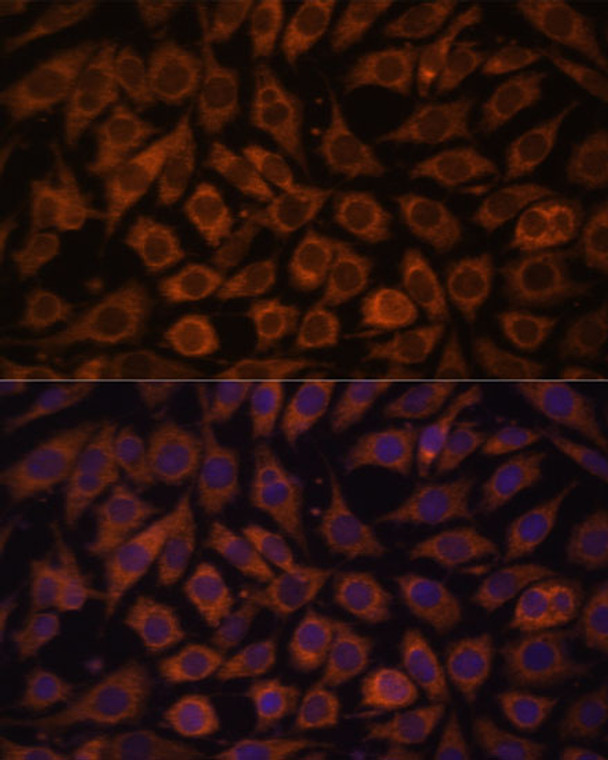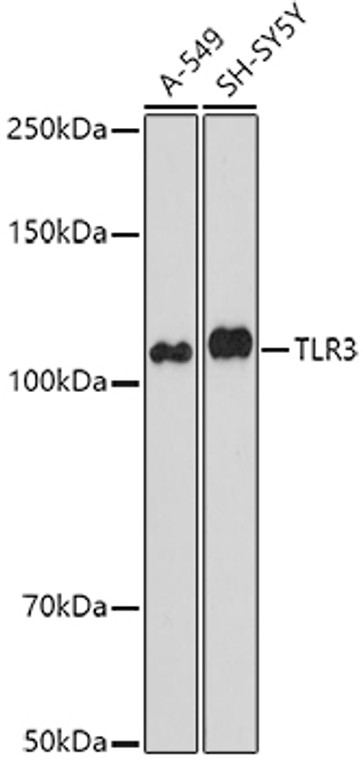| Host: |
Rabbit |
| Applications: |
WB/IHC/IF |
| Reactivity: |
Human/Mouse/Rat |
| Note: |
STRICTLY FOR FURTHER SCIENTIFIC RESEARCH USE ONLY (RUO). MUST NOT TO BE USED IN DIAGNOSTIC OR THERAPEUTIC APPLICATIONS. |
| Short Description: |
Rabbit polyclonal antibody anti-TLR3 (500-700) is suitable for use in Western Blot, Immunohistochemistry and Immunofluorescence research applications. |
| Clonality: |
Polyclonal |
| Conjugation: |
Unconjugated |
| Isotype: |
IgG |
| Formulation: |
PBS with 0.05% Proclin300, 50% Glycerol, pH7.3. |
| Purification: |
Affinity purification |
| Dilution Range: |
WB 1:100-1:500IHC-P 1:50-1:200IF/ICC 1:50-1:200 |
| Storage Instruction: |
Store at-20°C for up to 1 year from the date of receipt, and avoid repeat freeze-thaw cycles. |
| Gene Symbol: |
TLR3 |
| Gene ID: |
7098 |
| Uniprot ID: |
TLR3_HUMAN |
| Immunogen Region: |
500-700 |
| Immunogen: |
Recombinant fusion protein containing a sequence corresponding to amino acids 500-700 of human TLR3 (NP_003256.1). |
| Immunogen Sequence: |
SPFQPLRNLTILDLSNNNIA NINDDMLEGLEKLEILDLQH NNLARLWKHANPGGPIYFLK GLSHLHILNLESNGFDEIPV EVFKDLFELKIIDLGLNNLN TLPASVFNNQVSLKSLNLQK NLITSVEKKVFGPAFRNLTE LDMRFNPFDCTCESIAWFVN WINETHTNIPELSSHYLCNT PPHYHGFPVRLFDTSSCKDS A |
| Tissue Specificity | Expressed at high level in placenta and pancreas. Also detected in CD11c+ immature dendritic cells. Only expressed in dendritic cells and not in other leukocytes, including monocyte precursors. TLR3 is the TLR that is expressed most strongly in the brain, especially in astrocytes, glia, and neurons. |
| Post Translational Modifications | Heavily N-glycosylated, except on that part of the surface of the ectodomain that is involved in ligand binding. TLR3 signaling requires a proteolytic cleavage mediated by cathepsins CTSB and CTSH, the cleavage occurs between amino acids 252 and 346. The cleaved form of TLR3 is the predominant form found in endosomes. Ubiquitinated by TRIM3.leading to recognition and sorting of polyubiquitinated TLR3 by the ESCRT complexes. Ubiquitinated by ZNRF1 via 'Lys-63'-linked ubiquitin chains.leading to TLR3 lysosomal trafficking and degradation. |
| Function | Key component of innate and adaptive immunity. TLRs (Toll-like receptors) control host immune response against pathogens through recognition of molecular patterns specific to microorganisms. TLR3 is a nucleotide-sensing TLR which is activated by double-stranded RNA, a sign of viral infection. Acts via the adapter TRIF/TICAM1, leading to NF-kappa-B activation, IRF3 nuclear translocation, cytokine secretion and the inflammatory response. |
| Protein Name | Toll-Like Receptor 3Cd Antigen Cd283 |
| Database Links | Reactome: R-HSA-1679131Reactome: R-HSA-168164Reactome: R-HSA-168927Reactome: R-HSA-1810476Reactome: R-HSA-5602410Reactome: R-HSA-5602415Reactome: R-HSA-5602566Reactome: R-HSA-5602571Reactome: R-HSA-9013957Reactome: R-HSA-9013973Reactome: R-HSA-9014325 |
| Cellular Localisation | Endoplasmic Reticulum MembraneSingle-Pass Type I Membrane ProteinEndosome MembraneEarly Endosome |
| Alternative Antibody Names | Anti-Toll-Like Receptor 3 antibodyAnti-Cd Antigen Cd283 antibodyAnti-TLR3 antibody |
Information sourced from Uniprot.org
12 months for antibodies. 6 months for ELISA Kits. Please see website T&Cs for further guidance











